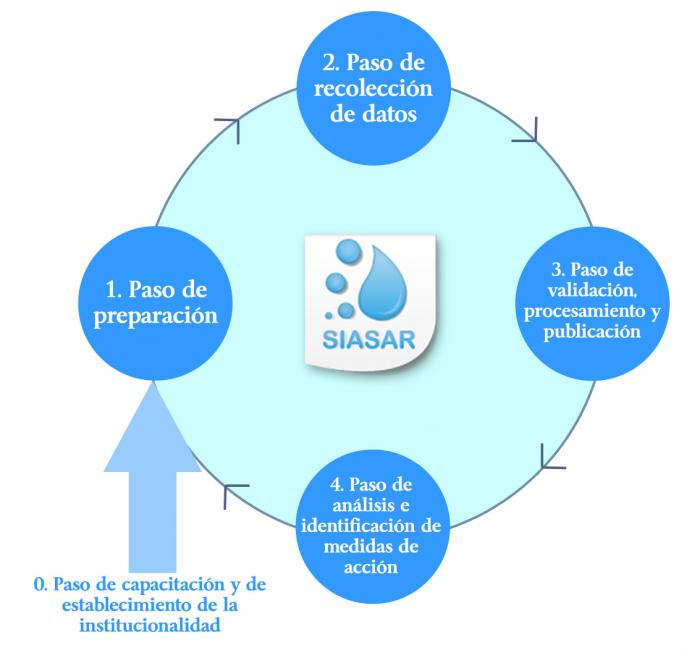During an interview about mapping rural water supply via a web-based system, we hit our first stumbling block.
Published on: 12/06/2013
The internet was so slow that it was practically non existent. And this happened while we were talking about the implementation of the new monitoring system, which is supposed to be web-based!
The communication hiccup occurred during my first field visit to the Municipality of Lepaterique in the Department of Francisco Morazán, Honduras. The objective of this field visit was to synthesise the experiences with the pilot application of the SIASAR (Rural Water and Sanitation Information System) monitoring system, as rolled out by the national utility (SANAA). This first pilot should form the basis for the wider mapping of 2,000 rural water supply systems, and provide lessons and good practices for its wider application at national level.

SIASAR is a monitoring system to assess the status of rural water supply services and their service providers. Data collection happens through the use of Android phones or tablets. After that it is sent to a central server, which processes all the data through a series of algorithms and provides a score on the performance of the service and the service provider. Both the overall scores and underlying indicators can be accessed online, to be used for decision-making.
One of the issues I particularly wanted to dig into deeper is why, various months after data collection and processing had taken place, the last step in monitoring, i.e. the joint analysis between SANAA and the municipality still hadn’t taken place (see diagram of the supposed monitoring process). A similar situation presented itself in the Municipality of Florida in the Department of Copán, with the only difference that the pilot was led there by PIR (Rural Infrastructure Programme), a programme of FHIS (Honduran Social Investment Fund), another government body. Though in this pilot, the emphasis was more on calibrating the technical performance of SIASAR, particularly the algorithms, much of the data collection and processing was done in a similar way as in Lepaterique. And in Florida, neither was there any internet access – a waste of money to have internet in the municipal offices, according to the Mayor.
In the interview with the technician, he mentioned he hadn't received any training in the use of the tool, let alone in doing analysis of the data.
In the interview with the technician of the Municipal Environment Unit, who has been responsible from the municipality’s side for implementing the SIASAR monitoring system, he mentioned he hadn’t received any training in the use of the tool, let alone in doing analysis of the data. However, on his own initiative he had started using the tool, in order to obtain some statistics on the water systems in the area, as an input for a project proposal. But he did so by calling via phone to the central system administrator, who then provided him with answers to his query, rather than using the web interface. In Florida, the technician also got some data for a project formulation, but without even accessing the system. In this municipality data were collected also through a paper-based survey form, alongside the ones on Androids, so as to check for errors in data entry. The technician went through all the paper forms that were stored in the municipality and compiled the data he needed.
Looking back at my field visits to both these municipalities, it is clear that the expectation that the municipalities would use the system to analyse the data of their areas of jurisdiction was too high an expectation. The technicians of SANAA and FHIS did a good job in data collection and processing, but they weren’t prepared to also do an analysis, or even more to facilitate a process of analysis with municipal stakeholders. Our gut feeling is that would require specific expertise, in either developing municipal investment plans or broader municipal capacity building, in which the analysis and use of data into such plans and processes is key.
In that sense, Florida is a step ahead. PIR contracted an external consultant to facilitate the formulation of a municipal water and sanitation policy. In preparation for this work, he crunched all the data on the water and sanitation status. However, he didn’t do this as a joint exercise with municipal stakeholders, which would have been a valuable step in building up the capacity for data processing and analysis.
Overall, the review is positive: the first steps in the monitoring process – data collection and processing – went relatively well, and the individual actions of the technicians indicate that there is a need and willingness to use data for planning. Hence there is good hope that the problems in this last step can also be overcome, by providing support to municipalities in using this tool for planning and the formulation of projects and programmes. In addition, there is this minor, but not so minor logistical detail of the “Error 503: Service not available”, as without internet access a web-based tool to monitor water services will obviously be of little service.
At IRC we have strong opinions and we value honest and frank discussion, so you won't be surprised to hear that not all the opinions on this site represent our official policy.